Self-healing rubber offers dynamic recovery from minor damage, enhancing chemical seal longevity in low to moderate exposure environments. Fluoroelastomer provides superior chemical resistance and thermal stability, ideal for seals exposed to aggressive chemicals and high temperatures.
Table of Comparison
| Property | Self-Healing Rubber | Fluoroelastomer |
|---|---|---|
| Chemical Resistance | Moderate; effective against mild chemicals | Excellent; resists strong acids, oils, and solvents |
| Self-Healing Ability | High; autonomously repairs minor cracks and cuts | None; requires manual replacement if damaged |
| Temperature Range | -30degC to 120degC | -40degC to 200degC |
| Durability | Moderate; improved lifespan due to self-repair | High; excellent long-term mechanical strength |
| Typical Applications | Low to medium chemical exposure seals | High chemical and temperature seals in automotive and aerospace |
| Cost | Moderate; innovative technology premium | High; specialized material cost |
Introduction to Chemical Seal Materials
Self-healing rubber and fluoroelastomer are key materials in chemical seals due to their distinct chemical resistance and durability properties. Self-healing rubber offers enhanced longevity by automatically repairing minor damages, making it ideal for dynamic sealing environments with frequent mechanical stress. Fluoroelastomers provide superior resistance to aggressive chemicals, high temperatures, and solvents, ensuring reliable sealing performance in harsh chemical processing applications.
Overview of Self-Healing Rubber Technology
Self-healing rubber technology utilizes dynamic polymer networks capable of autonomously repairing microcracks through reversible covalent bonds or hydrogen bonding, enhancing seal longevity in chemical environments. These elastomers restore their structural integrity without external intervention, offering improved resistance to chemical degradation compared to traditional materials. Compared to fluoroelastomers, which rely on inherent chemical inertness and thermal stability, self-healing rubbers provide innovative durability by actively mitigating damage caused by aggressive chemicals.
Understanding Fluoroelastomer Properties
Fluoroelastomers exhibit exceptional chemical resistance, withstanding aggressive solvents, acids, and bases, making them ideal for demanding chemical seal applications. Their thermal stability ranges up to 200-250degC, ensuring durability in high-temperature environments where self-healing rubbers may degrade. Compared to self-healing rubber, fluoroelastomers offer superior resistance to swelling, permeation, and compression set, crucial for maintaining seal integrity in harsh chemical conditions.
Chemical Resistance: Self-Healing Rubber vs Fluoroelastomer
Fluoroelastomers offer superior chemical resistance compared to self-healing rubber, excelling in environments with exposure to aggressive chemicals such as solvents, acids, and fuels. Self-healing rubber provides moderate chemical resistance and excels in sealing applications requiring durability under mechanical stress and minor damages. For critical chemical seal applications, fluoroelastomers ensure long-term integrity and resistance against harsh chemical degradation.
Durability and Longevity Comparison
Self-healing rubber exhibits exceptional durability due to its ability to autonomously repair microcracks, significantly extending seal lifespan under dynamic stress and abrasive chemical exposure. Fluoroelastomers (FKM) offer superior chemical resistance and maintain mechanical integrity in high-temperature, aggressive environments, ensuring long-term performance where conventional elastomers degrade. Comparing both materials, self-healing rubber excels in applications with frequent mechanical damage, while fluoroelastomers provide unmatched longevity in chemically aggressive conditions.
Performance Under Extreme Temperatures
Self-healing rubber demonstrates remarkable resilience in maintaining integrity and flexibility under extreme temperature fluctuations, making it ideal for chemical seals exposed to dynamic thermal stress. Fluoroelastomers exhibit superior chemical resistance and stable performance at high temperatures up to 200-250degC, ensuring durability in harsh chemical environments. While self-healing rubber enhances longevity through autonomous damage repair, fluoroelastomers provide consistent sealing performance under sustained thermal and chemical exposure.
Maintenance and Repair Considerations
Self-healing rubber offers significant advantages in chemical seal applications by automatically repairing minor surface damages, reducing downtime and maintenance costs. Fluoroelastomers, known for exceptional chemical resistance and thermal stability, require less frequent replacement but can be more challenging and costly to repair once damaged. Maintenance strategies should balance the self-repair capabilities of self-healing rubber with the durable, albeit less repair-friendly, nature of fluoroelastomers for optimal lifecycle management.
Cost Analysis and Economic Impact
Self-healing rubber offers cost advantages in chemical seal applications by reducing replacement frequency and downtime, leading to lower long-term maintenance expenses compared to fluoroelastomers. Although fluoroelastomers have higher initial costs due to superior chemical resistance and durability, their lifespan in aggressive environments can offset upfront investment through decreased failure rates. Economic impact analysis shows that selecting self-healing rubber can optimize operational budgets in moderate chemical exposure scenarios, while fluoroelastomers remain economically viable for high-risk, corrosive conditions where seal integrity is critical.
Environmental and Safety Aspects
Self-healing rubber offers enhanced environmental benefits due to its ability to automatically repair minor damages, extending seal lifespan and reducing waste in chemical sealing applications. Fluoroelastomers provide exceptional chemical resistance and stability under harsh conditions, minimizing the risk of toxic leaks and ensuring safer containment of aggressive chemicals. The choice between self-healing rubber and fluoroelastomer depends on balancing environmental impact by waste reduction against superior chemical resistance for safety in industrial environments.
Choosing the Right Material for Chemical Seal Applications
Self-healing rubber offers exceptional durability and the ability to recover from minor damages, making it ideal for chemical seals exposed to mechanical stress and abrasive environments. Fluoroelastomers provide superior chemical resistance and thermal stability, excelling in seals that must withstand aggressive chemicals and high temperatures. Selecting between self-healing rubber and fluoroelastomer depends on specific application requirements, balancing the need for robust mechanical recovery versus advanced chemical and thermal resistance.

Infographic: Self-healing rubber vs Fluoroelastomer for Chemical seal
 azmater.com
azmater.com